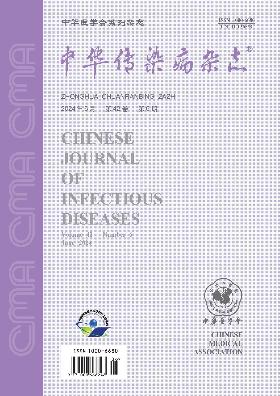某综合医院血培养结核分枝杆菌阳性患者的临床特点
引用次数: 0
摘要
目的回顾性分析血培养阳性结核分枝杆菌患者的临床和实验室特点。方法收集2009年1月至2017年1月复旦大学附属华山医院疑似播散性结核病患者的临床实验室数据库并进行分析。比较结核分枝杆菌血培养阳性(血培养阳性组)与阴性(血培养阴性组)弥散性结核患者的临床表现、实验室特征及转归。采用T检验、Mann-Whitney U检验和Fisher精确检验进行统计分析。结果5 589例疑似结核分枝杆菌感染患者行外周血分枝杆菌培养。26例弥散性结核患者血培养结核分枝杆菌阳性,6例经菌种鉴定最终鉴定为非结核分枝杆菌(NTM),同期纳入22例血培养阴性的弥散性结核患者作为对照。平均年龄([49.1±10.1]岁vs[38.3±17.1]岁,t=2.460, P=0.018),入院时诊断为不明原因发热的比例(FUO) (65.0%[13/20] vs 13.6%[3/22], P=0.001),诊断为局灶性感染的比例(30.0%[6/20]vs 86.4%[19/22], P=0.001),合并其他疾病的比例(75.0%[15/20]vs 22.7%[5/22], P=0.002),合并血液病的比例(35.0%[7/20]vs 4.5%[1/22]),P=0.018),阳性血培养组肿瘤患者比例(20%[4/20]vs 0[0/22], P=0.043)与阴性血培养组差异有统计学意义。实验室检查:中性粒细胞百分比、淋巴细胞百分比、单核细胞百分比、中性粒细胞/淋巴细胞值、血红蛋白水平、红细胞沉降率水平、c反应蛋白水平、降钙素原水平、T-SPOT阳性率。阳性血培养组与阴性血培养组结核发生率差异有统计学意义(P<0.05)。结论老年弥散性结核伴血液病或肿瘤患者外周血结核分枝杆菌培养阳性,中性粒细胞计数和炎症标志物升高,淋巴细胞计数和血红蛋白降低。关键词:结核分枝杆菌;血培养;播散性肺结核本文章由计算机程序翻译,如有差异,请以英文原文为准。
Clinical characteristics of patients with positive blood culture for Mycobacterium tuberculosis in a general hospital
Objective
To retrospectively analyze the clinical and laboratory characteristics of patients with positive blood culture results for Mycobacterium tuberculosis (M.tb).
Methods
The clinical laboratory database of patients suspected with disseminated tuberculosis from January 2009 to January 2017 in Huashan Hospital affiliated with Fudan University were collected and analyzed. The clinical manifestations, laboratory characteristics and outcomes between disseminated tuberculosis patients with positive blood culture (positive blood culture group) for M. tb and negative results (negative blood culture group) were compared. T test, Mann-Whitney U test and Fisher exact test were used for statistical analysis.
Results
A total of 5 589 patients suspected with M. tb infection had peripheral blood culture for mycobacterium. Positive blood culture for M. tb was found in 26 disseminated tuberculosis patients, while 6 patients finally identified as nontuberculous mycobacterium (NTM) with species identification, and 22 disseminated tuberculosis patients with negative blood culture results were enrolled during the same period as control. The mean age ([49.1±10.1] years old vs[38.3±17.1] years old, t=2.460, P=0.018), the proportion of diagnosed with fever of unknown origin at admission (FUO) (65.0%[13/20] vs 13.6%[3/22], P=0.001), the proportion of diagnosed with focal infection (30.0%[6/20] vs 86.4%[19/22], P=0.001), the proportion of patients with other diseases (75.0%[15/20] vs 22.7%[5/22], P=0.002), the proportion of patients with hematological diseases (35.0%[7/20] vs 4.5%[1/22], P=0.018) and the proportion of patients with tumor (20%[4/20] vs 0[0/22], P=0.043) in the positive blood culture group were significantly different from those in the negative blood culture group. Laboratory examinations of the percentage of neutrophils, the percentage of lymphocytes, the percentage of monocytes, the value of neutrophil/lymphocyte, the level of hemoglobin, the level of erythrocyte sedimentation rate, the level of C-reactive protein, the level of procalcitonin and the positive rate of T-SPOT.TB in positive blood culture groups were significantly different from those in negative blood culture group (all P<0.05).
Conclusions
Peripheral blood M. tb culture is more likely to be positive for those elder disseminated tuberculosis patients with hematological diseases or tumors, and those with increase of neutrophil counts and inflammation markers but reduction of lymphocyte counts and hemoglobin.
Key words:
Mycobacterium tuberculosis; Blood culture; Disseminated tuberculosis
求助全文
通过发布文献求助,成功后即可免费获取论文全文。
去求助
来源期刊
自引率
0.00%
发文量
5280
期刊介绍:
The Chinese Journal of Infectious Diseases was founded in February 1983. It is an academic journal on infectious diseases supervised by the China Association for Science and Technology, sponsored by the Chinese Medical Association, and hosted by the Shanghai Medical Association. The journal targets infectious disease physicians as its main readers, taking into account physicians of other interdisciplinary disciplines, and timely reports on leading scientific research results and clinical diagnosis and treatment experience in the field of infectious diseases, as well as basic theoretical research that has a guiding role in the clinical practice of infectious diseases and is closely integrated with the actual clinical practice of infectious diseases. Columns include reviews (including editor-in-chief reviews), expert lectures, consensus and guidelines (including interpretations), monographs, short monographs, academic debates, epidemic news, international dynamics, case reports, reviews, lectures, meeting minutes, etc.

 求助内容:
求助内容: 应助结果提醒方式:
应助结果提醒方式:


